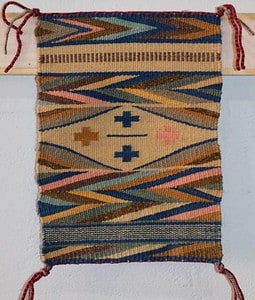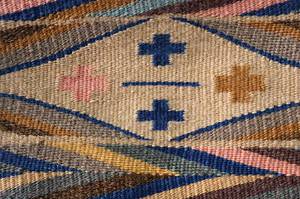The Whole is Greater
- Weaver: Gloria Claw Begay
- Weaver home: Navajo, New Mexico
- Size: 7″x10″
- Date Woven: January 2023
- Yarn: Commercially spun Navajo-Churro wool
- Dyes: Indigo, cochineal, black walnut, ground lichen
I titled Gloria Begay’s latest weaving “The Whole is Greater.” Why? It’s a lot of different parts. It’s a Navajo-Churro wedge weave that has fine detail and natural dyes. Great parts, all of them, but I realized the whole is greater than the sum. Gloria’s telling a great weaving story in 70 square inches. Let me show you how.
Part 1: Wedge Weave
Wedge Weave emerged as a technique around the Long Walk period (1864-1868), when the Navajo people were force-marched to the Bosque Redondo. Under horrific conditions, the weavers wove with the materials they had.
Hundreds of miles from home, they incorporated new designs that they saw. They created angled patterns on the bias, weaving sideways stripes. This method displaces the warp threads, creating scallops on the sides of the weaving. They manipulated the stripes as they wove, creating wearing blankets with highly complex patterns.
Wedge weave largely disappeared with the advent of rug weaving in the 1890s, but contemporary indigenous and non-indigenous weavers revived the technique. Gloria used wedge weave in four sections of this piece, and you can see the characteristic displacement of the warps in the picture at left.
Part 2: Navajo-Churro Wool
Gloria selected fine-weight Navajo-Churro wool for this weaving. OK, she possibly used up small pieces of Navajo Churro from other projects, but that’s the point. Navajo weavers don’t waste wool, and they especially don’t waste Navajo-Churro wool. Like the Navajos, these sheep have been the target of ill-conceived campaigns that decimated their numbers, nearly wiping them out.
Drought-tolerant, lean, and possessing nearly greaseless wool, these dual-coated sheep fed and clothed the Navajo people for hundreds of years. Gloria’s use of this wool for this weaving adds another piece to the whole.
Part 3: Fine Detail and Natural Dyes
Navajo-Churro went into the classic Chief Blankets. Fine spinning and fine detail enhanced the beauty of the wool. You can see both in the beautifully executed center of Gloria’s weaving. It features the Spiderwoman cross found in so many blankets. Weaving at 12 warps and 50 wefts per inch, the weaving is canvas-tight.
Shades of cochineal, indigo, black walnut, and ground lichen make up the color palette. These historic dyes tell more of the story. The Ancestral Puebloans traded many dyes, and the knowledge of these colorants was passed down and shared. The Navajo acquired cochineal-dyed fabrics to use as bayeta; they dyed with indigo and used many plant materials in their work.
The Whole is Greater Than The Sum
This description originally appeared in our online store. I transferred it here so that the rug can will tell this story every time someone reads it.
I know this description is way over the top. I’m not sorry. Let me know if you enjoyed reading it. I had a blast writing it. This weaving was sold on consignment, and Gloria received 85% of the purchase price.




All of the historic wedge weaves that I’ve seen were woven as blankets or throws.
As a wedge weaver (and student of Martha Stanley’s who brought the technique to many of us), I particularly liked this story. I love learning more about how wedge weave might have come about and why it disappeared for so long. It’s wonderful that so many Diné weavers are taking it up again. Was it originally woven as blankets? I also enjoy your description of churro wool which I now use and love it! I look forward to more posts like this. Thank you!
Great to hear from Weaving in Beauty! Looking forward to more. Many thanks for sharing Gloria’s wonderful weaving and the history (herstory) behind the wedge weave.
I’m so glad you posted this. I’m taking a weaving class after a long hiatus and I was just thinking that I need to find out when you will be having classes in the fall. I think I much prefer Navajo weaving to floor loom weaving.
Thank you for writing this and sharing it, Mary! I look forward to reading your “Rug of the Week” posts.
Well, that does it! I’m starting a “Weaving of the Week” feature! Thank you, Cheryl!
The story matched the weaving in being detailed and fine. Both are very welcome. And both of you are amazing in what you do.
Thank you, Teresa!
Beautiful rug and thank you for sharing the story……………
The response to the post has convinced me to try to do a “Weaving of the Week” feature! As far as I can tell, the wedge weave technique came about as weavers learned to adapt to diagonal line designs. The scallops on the edge were an added bonus. People seem not to have liked the scallops in rugs, so the technique was almost lost. It’s been revived and is gaining in popularity.
Don’t be sorry! I loved the story! Weavings should have a narrative. Made even more so by the Narrative. I hope you do even more often. Glorias rug is beautiful. Does the wedge weave technique make a rug more wearable or drape able on the body of the wearer?
This piece is lovely! Thank you for sharing the history and details about the project.
Thank you, Rosie! It started as a description written to help sell the rug. I decided to turn it into what I hope becomes a
“Weaving of the Week” feature.
The work is exquisite; the story inspiring. Thank you!
Thank you, Michelle! I’ve decided to try to do a “Rug of the Week” feature. This is the first one. I’m so glad that you liked it.
I loved your story about Gloria’s rug.
Interesting, informative, engaging, well written – I loved this.